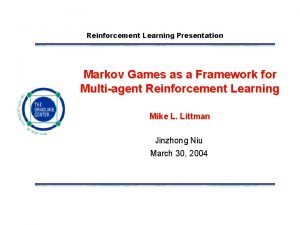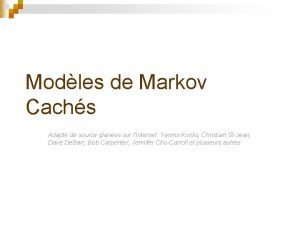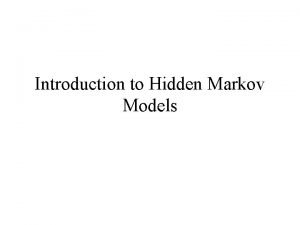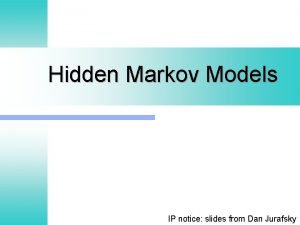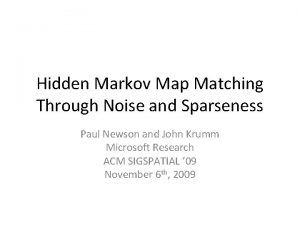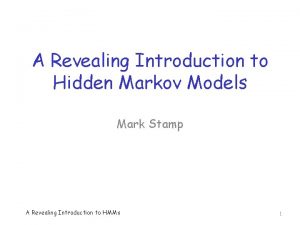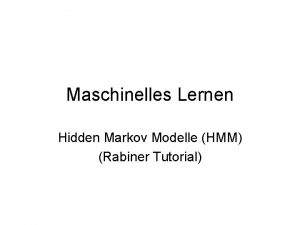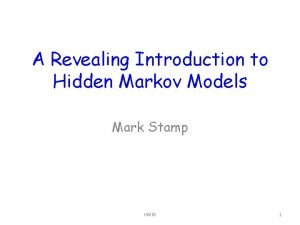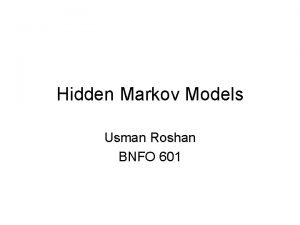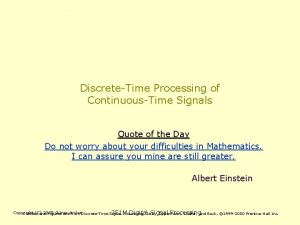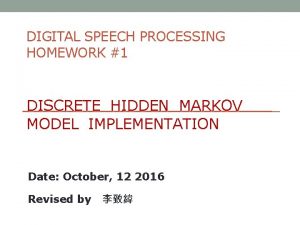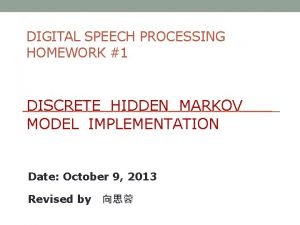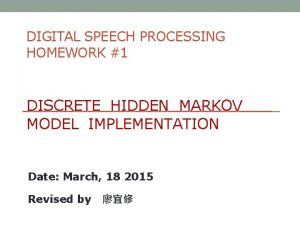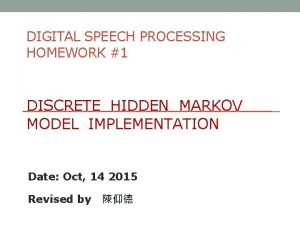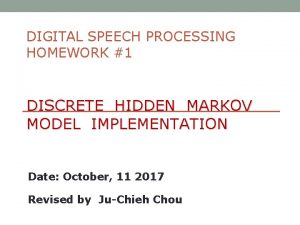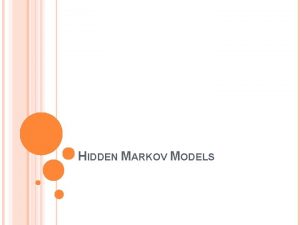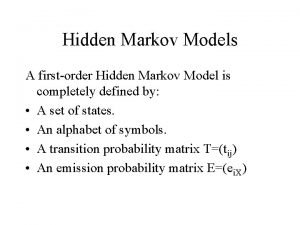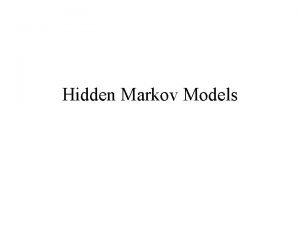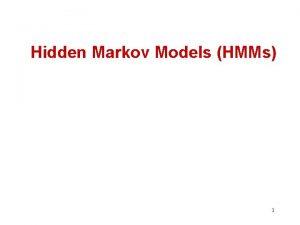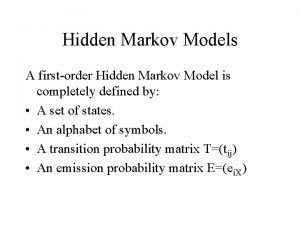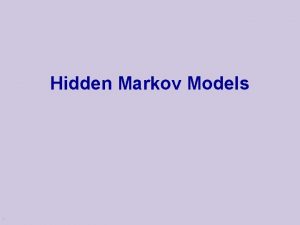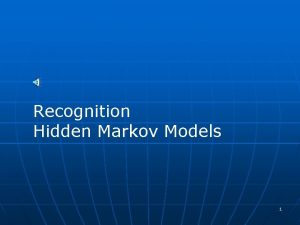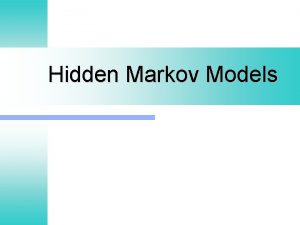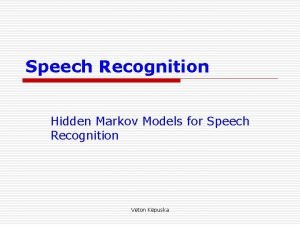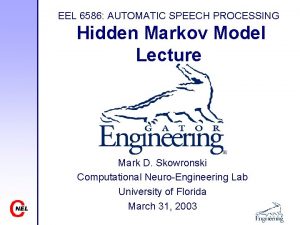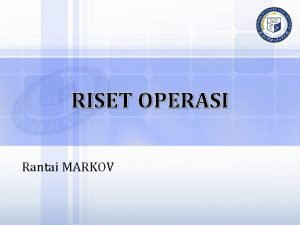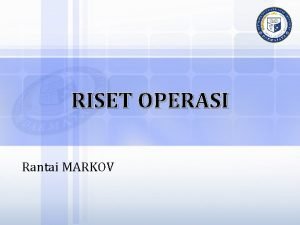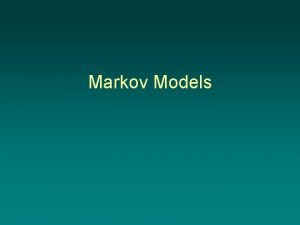Digital Speech Processing Homework 1 Discrete Hidden Markov






























![Submit Requirement Send to hpttw 0608@gmail. com Subject: [DSP] HW 1 r 99 xxxxxx Submit Requirement Send to hpttw 0608@gmail. com Subject: [DSP] HW 1 r 99 xxxxxx](https://slidetodoc.com/presentation_image_h/3152ef2412c6a43cc38c999b66e8fcfa/image-31.jpg)
![Submit Requirement Compress your hw 1 into “hw 1_[學號]. zip” +- hw 1_[學號]/ +- Submit Requirement Compress your hw 1 into “hw 1_[學號]. zip” +- hw 1_[學號]/ +-](https://slidetodoc.com/presentation_image_h/3152ef2412c6a43cc38c999b66e8fcfa/image-32.jpg)

- Slides: 33

Digital Speech Processing Homework #1 Discrete Hidden Markov Model Implementation Date: Oct. 27, 2010 Revised by Tsung-Wei Tu

Outline HMM in Speech Recognition Problems of HMM ◦ Training ◦ Testing File Format Submit Requirement 2

HMM in Speech Recognition 3

Speech Recognition In acoustic model, ◦ each word consists of syllables ◦ each syllable consists of phonemes ◦ each phoneme consists of some (hypothetical) states. “青色” → “青(ㄑㄧㄥ)色(ㄙㄜ、)” → ”ㄑ” → {s 1, s 2, …} Each phoneme can be described by a HMM (acoustic model). Each time frame, with an observance (MFCC vector) mapped to a state. 4

Speech Recognition Hence, there are state transition probabilities ( aij ) and observation distribution ( bj [ ot ] ) in each phoneme acoustic model. Usually in speech recognition we restrict the HMM to be a left-to-right model, and the observation distribution are assumed to be a continuous Gaussian mixture model. 5

Review left-to-right observation distribution are a continuous Gaussian mixture model 6

General Discrete HMM aij = P ( qt+1 = j | qt = i ) t, i, j. b j ( A ) = P ( o t = A | q t = j ) t, A , j. Given qt , the probability distributions of qt+1 and ot are completely determined. (independent of other states or observation) 7

HW 1 v. s. Speech Recognition Homework #1 set 5 Models Speech Recognition Initial-Final model_01~05 “ㄑ” {ot } A, B, C, D, E, F 39 dim MFCC unit an alphabet a time frame observatio n sequence voice wave 8

Problems of HMM 9

Problems of HMM Training ◦ Basic Problem 3 in Lecture 4. 0 Give O and an initial model = (A, B, ), adjust to maximize P(O| ) i = P( q 1 = i ) , Aij = aij , Bij = bj ( i ). ◦ Baum-Welch algorithm Testing ◦ Basic Problem 2 in Lecture 4. 0 Given model and O, find the best state sequences to maximize P(O| , q). ◦ Viterbi algorithm 10

Training Basic Problem 3: ◦ Give O and an initial model = (A, B, ), adjust to maximize P(O| ) i = P( q 1 = i ) , Aij = aij , Bij = bj ( i ). Baum-Welch algorithm A generalized expectation-maximization (EM) algorithm. 1. Calculate α (forward probabilities) and β (backward probabilities) by the observations. 2. Find ε and γ from α and β 3. Recalculate parameters ’ = ( A’ , B’ , ’ ) http: //en. wikipedia. org/wiki/Baum-Welch_algorithm 11

Forward Procedure 12

Forward Procedure by matrix αt+1 = AT * αt. * B ( o ( t +1) )T Calculate β by backward procedure is similar. 13

Calculate γ N * T matrix 14

Calculate ε The probability of transition from state i to state j given observation and model. Totally (T-1) N*N matrices. 15

Accumulate ε and γ through all samples not just all observations in one sample. 16

Re-estimate Model Parameters ’ = ( A’ , B’ , ’ ) 17

Testing Basic Problem 2: ◦ Given model and O, find the best state sequences to maximize P(O| , q). Calculate P(O| ) ≒ max P(O| , q) for each of the five models. The model with the highest probability for the most probable path usually also has the highest probability for all possible paths. 18

Viterbi Algorithm http: //en. wikipedia. org/wiki/Viterbi_algorithm 19

Flowchart testing_data. txt model_init. txt seq_model_ 01~05. txt train model_01. txt . . model_05. txt test CER testing_answer. txt 20

File Format 21

C or C++ snapshot 22

MATLAB snapshot 23

Input and Output of your programs Training algorithm ◦ input number of iterations initial model (model_init. txt) observed sequences (seq_model_01~05. txt) ◦ output =( A, B, ) 5 trained models 5 files of parameters for 5 models (model_01~05. txt) Testing algorithm ◦ input trained models (modellist. txt) Observed sequences (testing_data 1. txt & testing_data 2. txt) ◦ output best answer labels and P(O| ) (result 1. txt & result 2. txt) 24

Input Files +- dsp_hw 1/ +- c_cpp/ | ++- matlab/ | ++- modellist. txt //the list of models to be trained +- model_init. txt //HMM initial models +- seq_model_01~05. txt //training data observation +- testing_data 1. txt //testing data observation +- testing_answer. txt //answer for “testing_data 1. txt” +- testing_data 2. txt //testing data without answer 25

Model Format model parameters. ( model_01. txt ) 0 1 2 3 4 5 initial: 6 0. 22805 0. 02915 0. 12379 0. 18420 0. 00000 0. 43481 0 1 2 3 4 5 transition: 6 0. 36670 0. 51269 0. 17125 0. 53161 0. 31537 0. 08201 0. 24777 0. 06364 0. 09149 0. 05842 0. 29564 0. 06203 0. 08114 0. 26536 0. 06787 0. 06607 0. 00141 0. 00153 0. 00217 0. 02538 0. 49395 0. 48348 0. 00303 0. 00017 A B C D E F observation: 6 0. 34292 0. 55389 0. 08053 0. 16186 0. 13727 0. 10949 0. 45833 0. 19536 0. 00147 0. 00072 0. 00000 0. 18097 0. 42137 0. 28189 0. 01585 0. 12113 0. 00001 0. 06694 0. 01863 0. 09414 0. 02412 0. 09857 0. 06969 0. 15020 0. 12050 0. 37143 0. 01016 0. 07078 0. 36145 0. 76911 0. 02559 0. 07438 0. 00001 0. 68433 0. 04579 0. 02003 0. 01727 0. 00068 0. 00572 0. 00913 0. 03167 0. 01540 0. 12364 0. 59082 0. 25483 0. 38311 0. 25753 Prob( q 1=3|HMM) = 0. 18420 Prob(qt+1=4|qt=2, HMM) = 0. 00913 Prob(ot=B|qt=3, HMM) = 0. 02412 26

Observation Sequence Format seq_model_01~05. txt ACCDDDDFFCCCCBCFFFCCCCCEDADCCAEFCCCACDDFFCCD CABACCAFCCFFCCCDFFCCCCCDFFCDDDDFCDDCCFCCCEFFCCCCBC ABACCCDDDDFBCCCCCDDAACFBCCBCCCCCCCFFFCCCCCDBF AAABBBCCFFBDCDDFFACDCDFCDDFFFFFCDFFFCCCDCFFFFCCCCD AACCDCCCCCCCDCEDCBFFFCDCDCDAFBCDCFFCCDCCCEACDBAFFF CBCCCCDCFFCCCFFFFFBCCACCDCFCBCDDDCDCCDDBAADCCBFFCC CABCAFFFCCADCDCDDFCDFFCDDFFFCCCDDFCACCCCDCDFFCCAFF BAFFFFFFFCCCCDDDFFCCACACCCDDDFFFCBDDCBEADDCCDDACCF BACFFCCACEDCFCCEFCCCFCBDDDDFFFCCDDDFCCCDCCCADFCCBB …… 27

Model List Format Model list: modellist. txt testing_answer. txt model_01. txt model_02. txt model_03. txt model_04. txt model_05. txt model_01. txt model_02. txt model_04. txt model_03. txt model_05. txt model_04. txt ……. 28

Testing Output Format result 1. txt Hypothesis model and it likelihood model_01. txt model_05. txt model_03. txt ……. 1. 0004988 e-40 6. 3458389 e-34 1. 6022463 e-41 Calculate the classification accuracy. 29

Program Format Example In C / C++ . /train iteration model_init. txt seq_model_01. txt. /test modellist. txt testing_data. txt result. txt In Matlab train. Model( iteration, ‘model_init. txt’, ‘seq_model_01. txt’, ‘model_01. txt’); test. Model( ‘modellist. txt’, ‘testing_data. txt’, ‘result. txt’); 30
![Submit Requirement Send to hpttw 0608gmail com Subject DSP HW 1 r 99 xxxxxx Submit Requirement Send to hpttw 0608@gmail. com Subject: [DSP] HW 1 r 99 xxxxxx](https://slidetodoc.com/presentation_image_h/3152ef2412c6a43cc38c999b66e8fcfa/image-31.jpg)
Submit Requirement Send to hpttw 0608@gmail. com Subject: [DSP] HW 1 r 99 xxxxxx Your program ◦ train. c, test. c, Makefile ◦ train. Model. m, test. Model. m Your 5 Models After Training ◦ model_01~05. txt Testing result and accuracy ◦ result 1~2. txt (for testing_data 1~2. txt) ◦ acc. txt (for testing_data 1. txt) Document ( doc/pdf/html ) ◦ Name, student ID, summary of your results ◦ Specify your environment and how to execute. 31
![Submit Requirement Compress your hw 1 into hw 1學號 zip hw 1學號 Submit Requirement Compress your hw 1 into “hw 1_[學號]. zip” +- hw 1_[學號]/ +-](https://slidetodoc.com/presentation_image_h/3152ef2412c6a43cc38c999b66e8fcfa/image-32.jpg)
Submit Requirement Compress your hw 1 into “hw 1_[學號]. zip” +- hw 1_[學號]/ +- train. c (train. Model. m) +- test. c (test. Model. m) +- Makefile (none for Matlab) +- model_01~05. txt +- result 1~2. txt +- acc. txt +- Document (doc/pdf/html ) 32

Contact TA hpttw 0608@gmail. com Office Hour: Tue 13: 00~14: 00 & Wed 13: 00~14: 00/電二531 Please let us know you‘re coming by email, thanks! 語音實驗室 涂宗瑋 33
 Hidden markov chain
Hidden markov chain Hidden markov model rock paper scissors
Hidden markov model rock paper scissors Hidden markov model tutorial
Hidden markov model tutorial Hidden markov chain
Hidden markov chain Hidden markov chain
Hidden markov chain Hidden markov map matching through noise and sparseness
Hidden markov map matching through noise and sparseness A revealing introduction to hidden markov models
A revealing introduction to hidden markov models Rabiner hmm
Rabiner hmm A revealing introduction to hidden markov models
A revealing introduction to hidden markov models Hidden markov model
Hidden markov model Hidden markov models
Hidden markov models Histogram processing in digital image processing
Histogram processing in digital image processing High boost filtering matlab
High boost filtering matlab Nonlinear image processing
Nonlinear image processing پردازش تصویر
پردازش تصویر Point processing
Point processing Morphological processing in digital image processing
Morphological processing in digital image processing Markov chain natural language processing
Markov chain natural language processing Homework oh homework
Homework oh homework Homework oh homework i hate you you stink
Homework oh homework i hate you you stink Jack prelutsky homework oh homework
Jack prelutsky homework oh homework Homework oh homework jack prelutsky
Homework oh homework jack prelutsky Homework oh homework i hate you you stink
Homework oh homework i hate you you stink Literal language
Literal language Two figures of speech that involve comparisons are?
Two figures of speech that involve comparisons are? Discrete time processing of continuous time signals
Discrete time processing of continuous time signals Bottom up processing
Bottom up processing Bottom up processing vs top down processing
Bottom up processing vs top down processing Bottom up and top down processing
Bottom up and top down processing Primary food production
Primary food production Parallel processing vs concurrent processing
Parallel processing vs concurrent processing Top down processing
Top down processing Batch processing vs interactive processing
Batch processing vs interactive processing Digital image processing diagram
Digital image processing diagram

